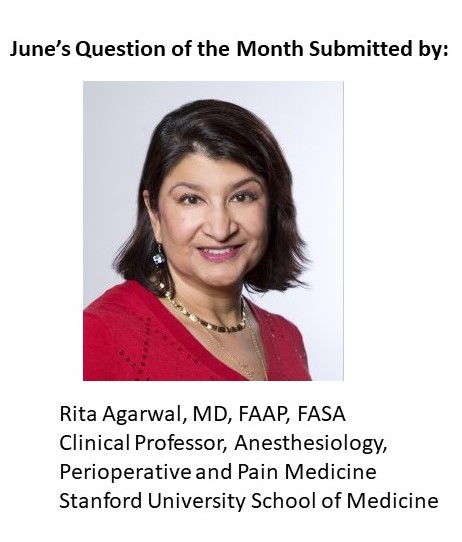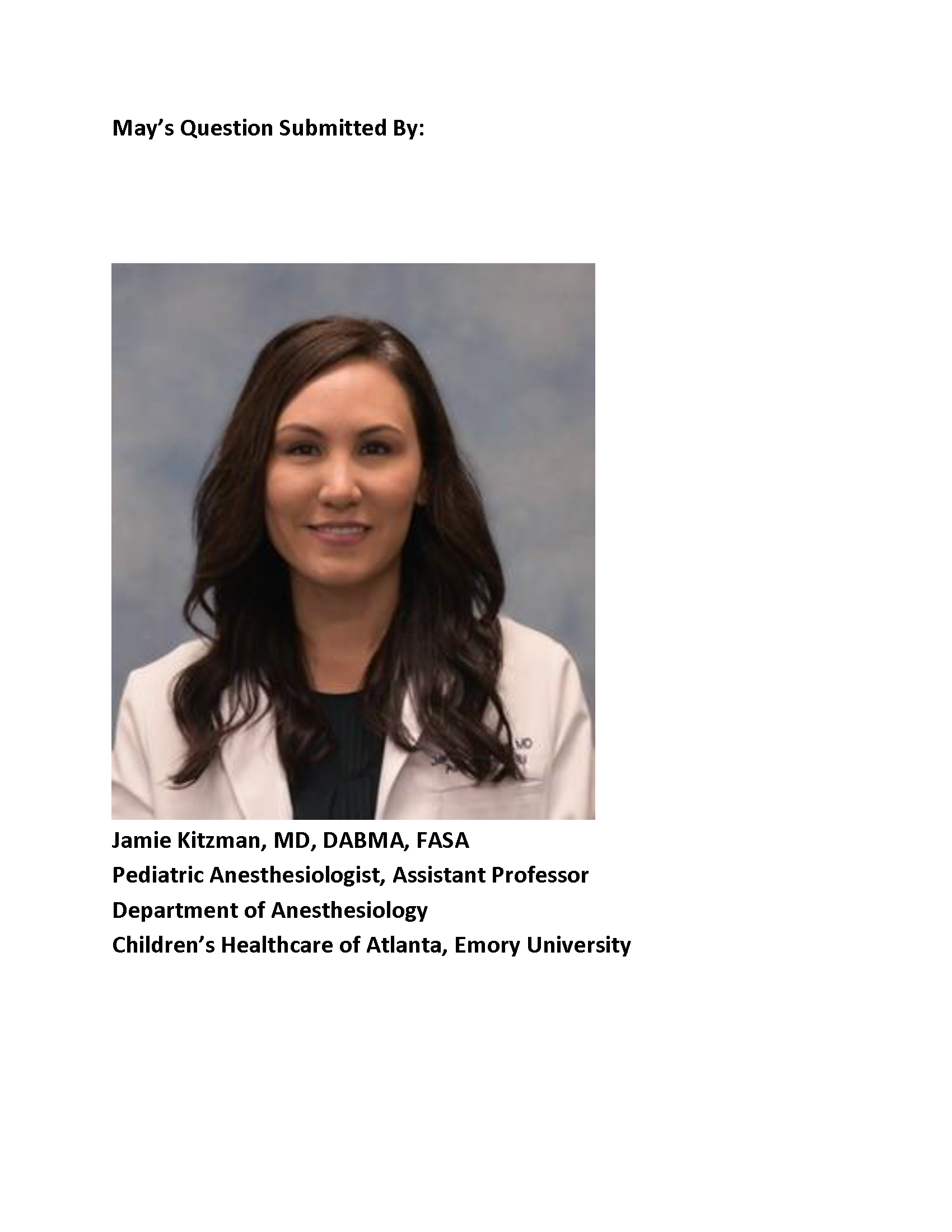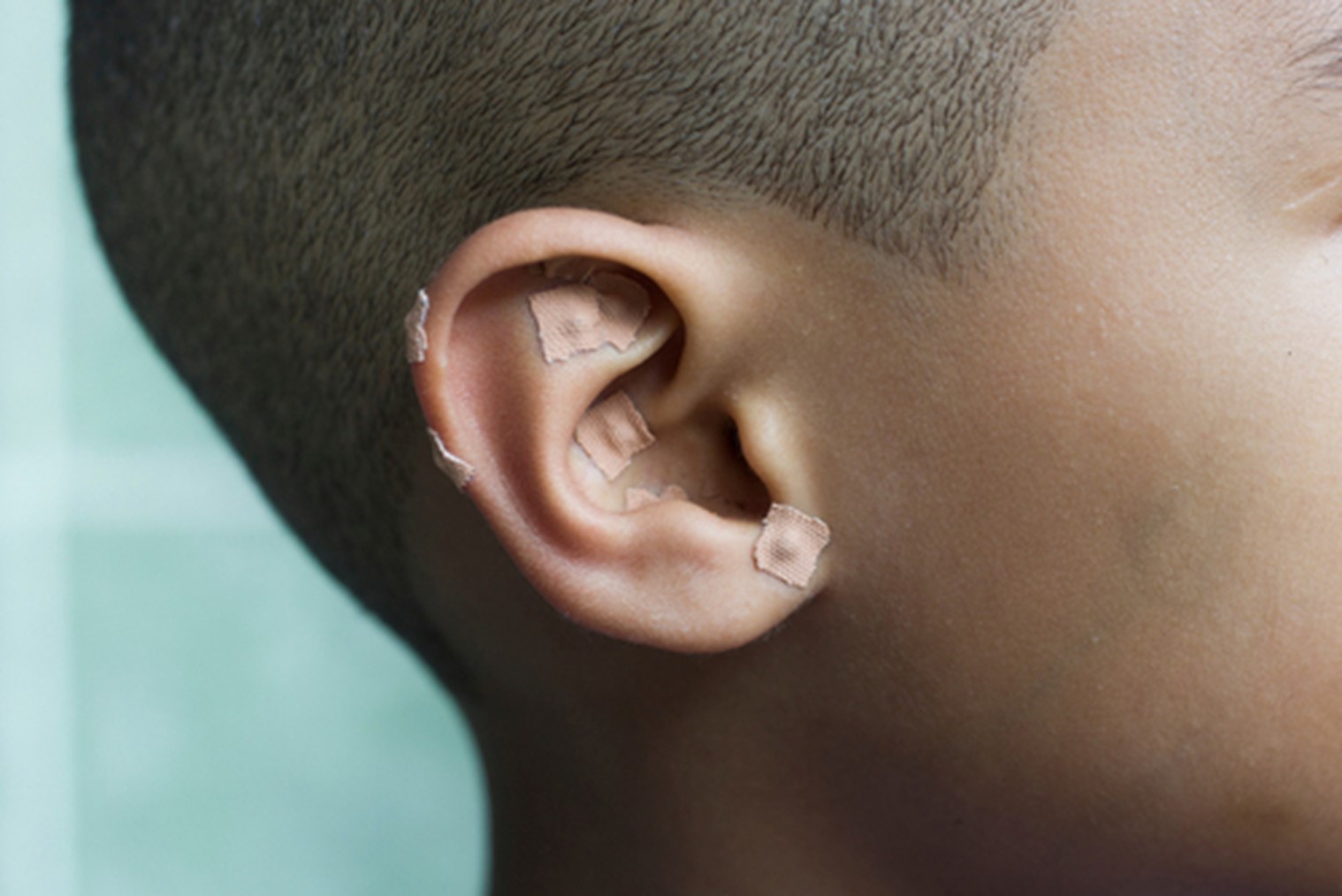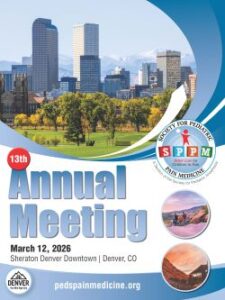
A 6-month-old male, otherwise healthy, presented to an ambulatory surgical center for a revision circumcision. The child underwent an uneventful inhalation induction, placement of a peripheral intravenous catheter and a secured endotracheal tube. The surgeon prepped, draped and performed a surgical time out, after which there was placement of a penile block with 0.5% bupivacaine without difficulty. Within seconds of the local anesthetic injection, the patient became hypotensive and bradycardic. PALS protocol was initiated and it was quickly determined that local anesthetic systemic toxicity (LAST) was the likely diagnosis. What is the next step in treatment?
Correct!
Wrong!
Question of the Month - July 2022
The correct answer is - C : Increase FiO2 to 100% and stop volatile anesthetic
In this LAST scenario, recognition of the problem occurred quickly and PALS was initiated. The patient already has a secured airway. While many of the above answers would all be happening simultaneously, the next step should be to remove the volatile anesthetic which will contribute to the hypotension which is caused by the intravascular injection of local anesthesia. Before lipid infusion was used, there was only supportive therapy until the local anesthestic could be metabolized.
The definitive treatment of LAST is Intralipid which creates a lipid “sink” or gradient to draw bupivacaine out of the tissue into lipid micelles so that the cardiac and neurological pharmacodynamic effects are minimized. The initial treatment is 1.5 ml/kg bolus over one minute followed by the initiation of an infusion of lipid at 0.25 mL/kg/min. If after 5 min, there is no change in the patient status, then another bolus of 1.5 mL/kg may be given and the infusion should be increased to 0.5 mL/kg/min. The lipid infusion should last for 10 min after return of hemodynamic stability. PediCrisis notes that the maximum intralipid volume is 10 mL/kg over the first 30 minutes.
Epinephrine is a very important component of standard PALS protocols. However, in LAST, epinephrine decrease lipid resuscitation and should be used in small bolus doses.
References:
1. Jones Oguh, S; Kraemer, F. Pediatric Local Anesthetic Systemic Toxicity. SPPM News. Spring 2022.
2. Pedi Crisis application on iOS (Apple Inc., Cupertino, CA)
3. Weinberg, G., Rupnik, B., Aggarwal, N., Fettiplace, M., & Gitman, M. (2020, February). APSF Newsletter. Retrieved June 30, 2022, from https://www.apsf.org/article/local-anesthetic-systemic-toxicity-last-revisited-a-paradigm-in-evolution/.
In this LAST scenario, recognition of the problem occurred quickly and PALS was initiated. The patient already has a secured airway. While many of the above answers would all be happening simultaneously, the next step should be to remove the volatile anesthetic which will contribute to the hypotension which is caused by the intravascular injection of local anesthesia. Before lipid infusion was used, there was only supportive therapy until the local anesthestic could be metabolized.
The definitive treatment of LAST is Intralipid which creates a lipid “sink” or gradient to draw bupivacaine out of the tissue into lipid micelles so that the cardiac and neurological pharmacodynamic effects are minimized. The initial treatment is 1.5 ml/kg bolus over one minute followed by the initiation of an infusion of lipid at 0.25 mL/kg/min. If after 5 min, there is no change in the patient status, then another bolus of 1.5 mL/kg may be given and the infusion should be increased to 0.5 mL/kg/min. The lipid infusion should last for 10 min after return of hemodynamic stability. PediCrisis notes that the maximum intralipid volume is 10 mL/kg over the first 30 minutes.
Epinephrine is a very important component of standard PALS protocols. However, in LAST, epinephrine decrease lipid resuscitation and should be used in small bolus doses.
References:
1. Jones Oguh, S; Kraemer, F. Pediatric Local Anesthetic Systemic Toxicity. SPPM News. Spring 2022.
2. Pedi Crisis application on iOS (Apple Inc., Cupertino, CA)
3. Weinberg, G., Rupnik, B., Aggarwal, N., Fettiplace, M., & Gitman, M. (2020, February). APSF Newsletter. Retrieved June 30, 2022, from https://www.apsf.org/article/local-anesthetic-systemic-toxicity-last-revisited-a-paradigm-in-evolution/.

 Auriculotherapy is a form of acupuncture that utilizes acupuncture points on the ear. Which of the following statements are true regarding auriculotherapy?
Auriculotherapy is a form of acupuncture that utilizes acupuncture points on the ear. Which of the following statements are true regarding auriculotherapy?


 SPPM 13th Annual Meeting
SPPM 13th Annual Meeting